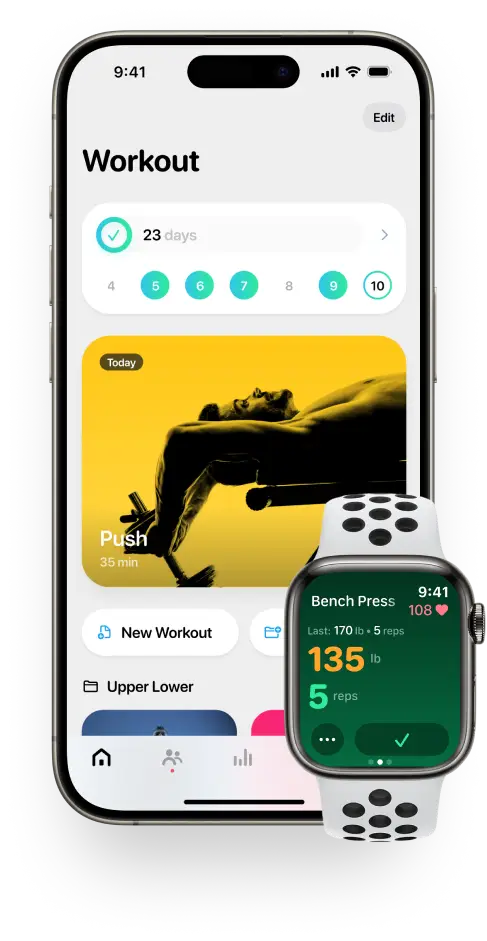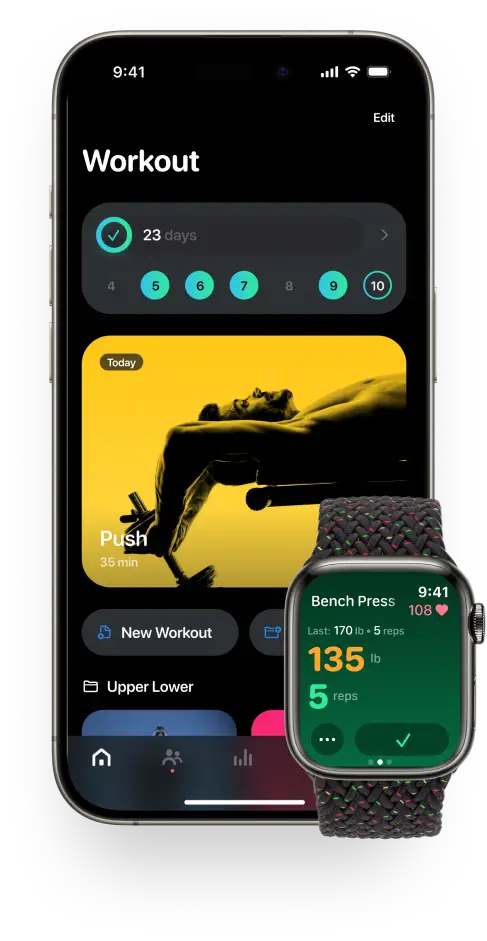TDEE Calculator Explained: Find Out Your Energy Needs
Knowing your Total Daily Energy Expenditure (TDEE) is the first step in tailoring your nutrition and exercise plans.
Some say that the key to losing weight is to track your calories, and a TDEE Calculator is a vital tool for anyone looking to understand their body's energy needs.
Whether you're trying to lose weight, gain muscle, or maintain your current physique, understanding your Total Daily Energy Expenditure (TDEE) is essential. It helps you gain insight into how your body functions and how to align your energy intake with your personal goals.
It works just like the one rep max calculator, where you input some information and it gives you a tailor-made plan.
Let's explore what it is, how it works, and why it matters to you.
What Is a TDEE Calculator?
Basically, a TDEE Calculator is a digital tool designed to estimate the number of calories your body burns in a day.
These calculations include all the energy your body uses for essential functions like breathing and digestion (Basal Metabolic Rate, or BMR), as well as calories burned through daily activities and the Thermic Effect of Food (TEF).
By combining these factors, the calculator gives you a complete picture of your total daily energy expenditure.
This tool is incredibly versatile and used by fitness enthusiasts, dieticians, and health professionals to assess caloric needs and decide if they want lean or bulky muscles.
However, to get a better result it’s crucial to have right information about workouts, nutrition, supplements, and routines can help you achieve better results. For example, do you know if you can use fat burners without working out? Or if creatine helps with weight loss?
How to Use a TDEE Calculator
TDEE Calculator
Input your data and learn how to read the results.
TDEE Calculator
Enter your gender, age, height, weight, and activity level. This will estimate your Total Daily Energy Expenditure (TDEE).
Using a TDEE Calculator is easy and intuitive.
To begin, you’ll need to provide some basic information, including your age, gender, weight, height, and activity level. Each input plays a role in determining your caloric needs. Then, you have to put in your activity level, from sedentary to extra active.
- Sedentary (little or no exercise)
- Lightly active (light exercise/sports 1-3 days/week)
- Moderately active (moderate exercise/sports 3-5 days/week)
- Very active (hard exercise/sports 6-7 days a week)
- Extra active (very hard exercise/physical job)
For example, age and gender influence your metabolism, while weight and height affect your BMR. The activity level reflects how much you move throughout the day, ranging from light activities like walking to more intense workouts.
Once you input these details, the calculator processes the data using established formulas to provide an estimate of your TDEE. The result is an accurate measurement of how many calories you burn daily, helping you understand your energy requirements and how they align with your lifestyle or fitness objectives.
Activity Levels Explained
To help you use this calculator more easily, we provide detailed explanations of the activity levels so you can determine which category best fits your activity.
Sedentary
A sedentary lifestyle involves minimal physical activity beyond basic daily tasks like sitting, walking short distances, or light household chores. This category is typically suited for individuals who spend most of their day seated, such as those with desk jobs or limited movement routines, and engage in little to no structured exercise.

Lightly Active
Being lightly active means incorporating some form of mild physical activity into your routine. This could include walking for 20-30 minutes a few times a week, light stretching, or occasional low-intensity exercises. It's a step above sedentary, reflecting a lifestyle with modest movement but no consistent workout schedule.

Moderately Active
A moderately active person engages in regular physical activity that might include brisk walking, cycling, or exercising three to five times per week. This category suits individuals who balance daily movement with a mix of light and moderate-intensity workouts, making it an average activity level for those with a healthy, semi-active lifestyle.

Active
An active lifestyle involves consistent movement throughout the day and includes regular workouts or physically demanding tasks. This level is ideal for individuals who exercise five to six days a week, participate in sports, or have physically intense jobs, such as manual labor or caregiving.
Very Active
Very active individuals go beyond standard exercise routines by engaging in vigorous physical activity almost daily. This might include high-intensity interval training (HIIT), long-distance running, or heavy physical labor. This category fits those who prioritize fitness and lead highly physically demanding lifestyles.

Extra Active
The extra-active category represents individuals with the highest physical activity levels, such as athletes, competitive sports participants, or those with extremely labor-intensive jobs. These individuals often combine intense workouts or sports training with an already active daily schedule, requiring significantly higher caloric intake to meet their energy demands.

What Are the Benefits of Using TDEE Calculator
You may wonder why you need this calculator and how it can help you, here are the advantages of using such tools:
1. Understanding Caloric Needs
Do you want to set a dietary goal? Using the TDEE calculator helps you estimate the total number of calories you need to lose during a day based on your activity level.
2. Personalized Nutrition Guidance
By knowing your TDEE, you can tailor your caloric intake to meet specific goals:
- Weight Loss: Consume fewer calories than your TDEE.
- Weight Gain: Consume more calories than your TDEE.
- Weight Maintenance: Match your caloric intake to your TDEE
This personalized approach allows for more effective meal planning and helps prevent drastic dietary changes that might lead to unhealthy weight fluctuations.
3. Enhanced Fitness Planning
By understanding how many calories you burn, you can adjust workout intensity and duration to avoid unintentional weight loss or fatigue.
4. Improved Energy Management
Knowing your TDEE can help optimize energy levels throughout the day. By aligning food intake with energy needs, individuals often experience increased stamina and reduced fatigue, enabling better performance in daily activities and workouts
5. Awareness of Lifestyle Factors
Do you need to change your lifestyle? Well, this calculator can help you discover the answer to this question. The activity level and metabolic rate provide a comprehensive view of how daily habits affect caloric needs.
What the Results of This Calculation Mean
The TDEE Calculator provides a valuable framework for managing your nutrition. According to the Medical University of South Carolina, tracking your food intake can be very beneficial.
If your goal is weight maintenance, the TDEE represents the number of calories you need to consume daily to stay at your current weight. If you want to lose weight, eating fewer calories than your TDEE (a calorie deficit) can help.
On the other hand, if you're looking to gain weight or build muscle, consuming more calories than your TDEE (a calorie surplus) is necessary.
For example, if your TDEE is 2,200 calories:
- Eating 2,200 calories maintains your current weight.
- Eating 1,700 calories could help you lose about 1 pound per week.
- Eating 2,700 calories could help you gain about 1 pound per week.
These calculations empower you to make informed decisions about your diet and lifestyle.
Rather than following generic plans, you can customize your nutrition to align with your individual needs and goals.
TDEE Calculator Formula
The formula behind a TDEE Calculator is based on two primary steps. First, it calculates your Basal Metabolic Rate (BMR), which is the number of calories your body needs to function at rest. This is done using equations tailored for men and women:
- For men: BMR = 88.362 + (13.397 × weight in kg) + (4.799 × height in cm) − (5.677 × age in years)
- For women: BMR = 447.593 + (9.247 × weight in kg) + (3.098 × height in cm) − (4.330 × age in years)
Next, the BMR is multiplied by an activity factor that reflects your lifestyle:
- Sedentary: BMR × 1.2
- Lightly active: BMR × 1.375
- Moderately active: BMR × 1.55
- Very active: BMR × 1.725
- Extra active: BMR × 1.9
The result is your TDEE: an estimate of how many calories you burn daily based on your current activity level. This formula is highly effective for planning caloric intake tailored to your goals.
Final Thoughts
The TDEE Calculator is an essential tool for anyone seeking to better understand their body's energy requirements. Whether you're managing weight, pursuing fitness goals, or simply looking to lead a healthier lifestyle, knowing your Total Daily Energy Expenditure gives you the power to make informed decisions. You should also take a look at how often you should go to the gym.
By using this calculator, you can create a customized plan that aligns with your unique needs and goals. It takes the guesswork out of nutrition, offering a clear way to balance your energy intake with your desired outcomes. Instead of relying on generic advice, you can rely on precise data to fuel your journey toward improved health and fitness.
Remember, the numbers provided by the TDEE Calculator are a guide, not a rigid rulebook.
Use them as a foundation to create habits that are sustainable and adaptable. With the right balance of knowledge and action, you can achieve the results you’re aiming for and maintain them for the long term.
If you want professional help to track your workout routine, download the Flex fitness app today.
Related articles


Get fit with Flex
Build muscle & lose weight fast for free.
Available on iPhone + Apple Watch





